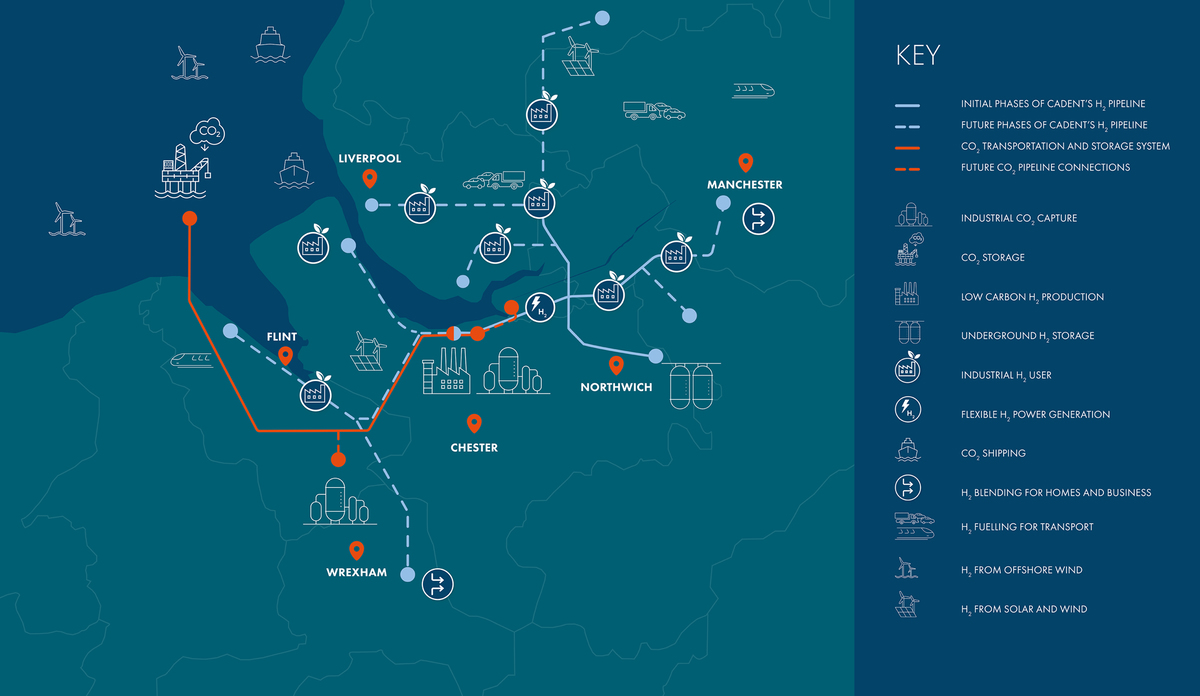UK doubles down on carbon capture and storage
UK has the "potential to be one of the greatest CO2 storage bases in Europe" with 78 billion mt storage capacity, said UK’s Secretary of State for Energy Security and Net Zero, Claire Coutinho.
 PHOTO: Project map of HyNet carbon capture cluster. HyNet
PHOTO: Project map of HyNet carbon capture cluster. HyNet
The shipping industry is encouraging the use of carbon capture technology to reduce the sector's carbon footprint. In addition, carbon dioxide (CO2) emitted during the production of fossil-based fuels like grey hydrogen and grey ammonia can be captured to produce blue hydrogen and blue ammonia.
Blue ammonia can reduce well-to-wake emissions by more than 90% compared to conventional fuels.
This CO2 captured from vessels' emissions or during the production of these fuels can be permanently stored deep underground or used to produce marine fuels like e-methanol, with zero-emission potential.
However, a recent study conducted by Mærsk Mc-Kinney Møller Center for Zero Carbon Shipping (MMMCZCS) forecast that the shipping sector will need 34 million mt/year of blue ammonia to reach net-zero emissions by 2050 and meet its 2030 targets. This would require a CO2 storage capacity of nearly 50 million mt/year, significantly more than the average global capacity of 40 million mt/year currently available.
And now the UK has stepped up to this challenge.
"UK has the potential to be one of the greatest CO2 storage bases in Europe", UK’s Secretary of State for Energy Security and Net Zero, Claire Coutinho asserted at the Carbon Capture & Storage Association annual conference.
The UK government estimates that a staggering 78 billion mt of CO2 can be stored on the UK's continental shelf.
“The North Sea Transition Authority estimates as much as 100 carbon stores will be needed to meet our net zero commitments. Well, we have the space, and then some,” Coutinho claimed.
 PHOTO: Project map of the East Coast carbon cluster. Northern Endurance Partnership
PHOTO: Project map of the East Coast carbon cluster. Northern Endurance Partnership
The UK government has pledged around £20 billion ($24.39 billion) to scale up CCS projects across the UK. It has also greenlighted eight CCS projects across two clusters – HyNet and East Coast Cluster – and is working on two more clusters.
HyNet cluster is expected to be operational by 2025, with an initial storage capacity of approximately 4.5 million mt/year of CO2, according to Italian oil major Eni, which is the transport and storage operator of the HyNet consortium.
In addition, Eni is planning another CCS cluster to decarbonise the Bacton Energy Hub and the Thames Estuary region in the UK. It has received a license to store CO2 in its depleted Hewett gas field.
“Together, HyNet North West and Bacton have the capacity to store 500 million tonnes of CO2,” ENI said.
The East Coast cluster is expected to be operational by 2027 with further expansion planned for 2030. The cluster's carbon storage site off the Yorkshire coast has a storage capacity of 10 million mt/year of CO2 by 2030, with a total storage capacity of 450 million mt.
The storage and transportation for this cluster will be handled by Northern Endurance Partnership – a joint venture between energy majors BP, Eni, Equinor, National Grid, Shell and Total.
While these clusters are primarily intended for storing industrial emissions, the involvement of these energy majors that also provide bunkering has opened the door to shipping to take advantage of these CO2 storage sites. The shipping industry could leverage this storage capacity to dramatically increase the production of low- and zero-emission marine fuels like blue ammonia.
The MMMCZCS report also stressed the need for shared CO2 storage across multiple industries rather than dedicated storage for the shipping industry only. Its argument was that multiple industries could bear the burden of infrastructure development, thus driving down carbon storage costs.
By Konica Bhatt
Please get in touch with comments or additional info to news@engine.online





